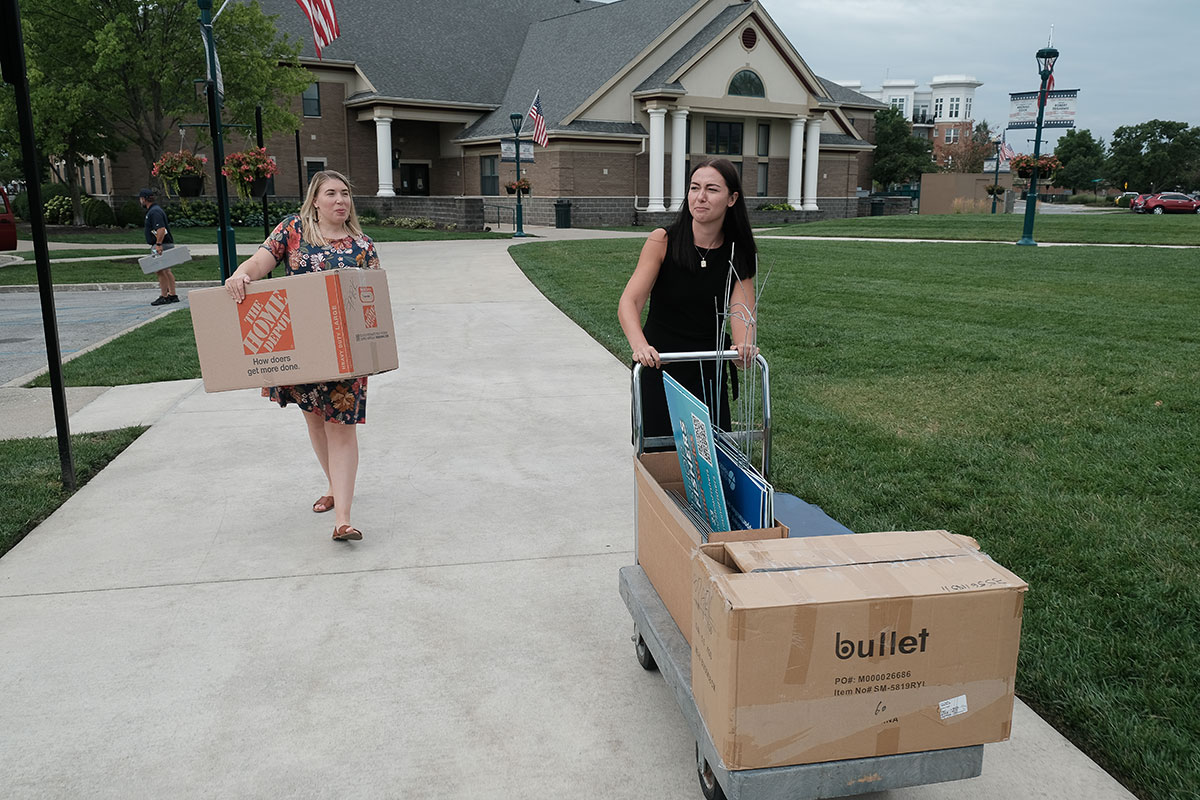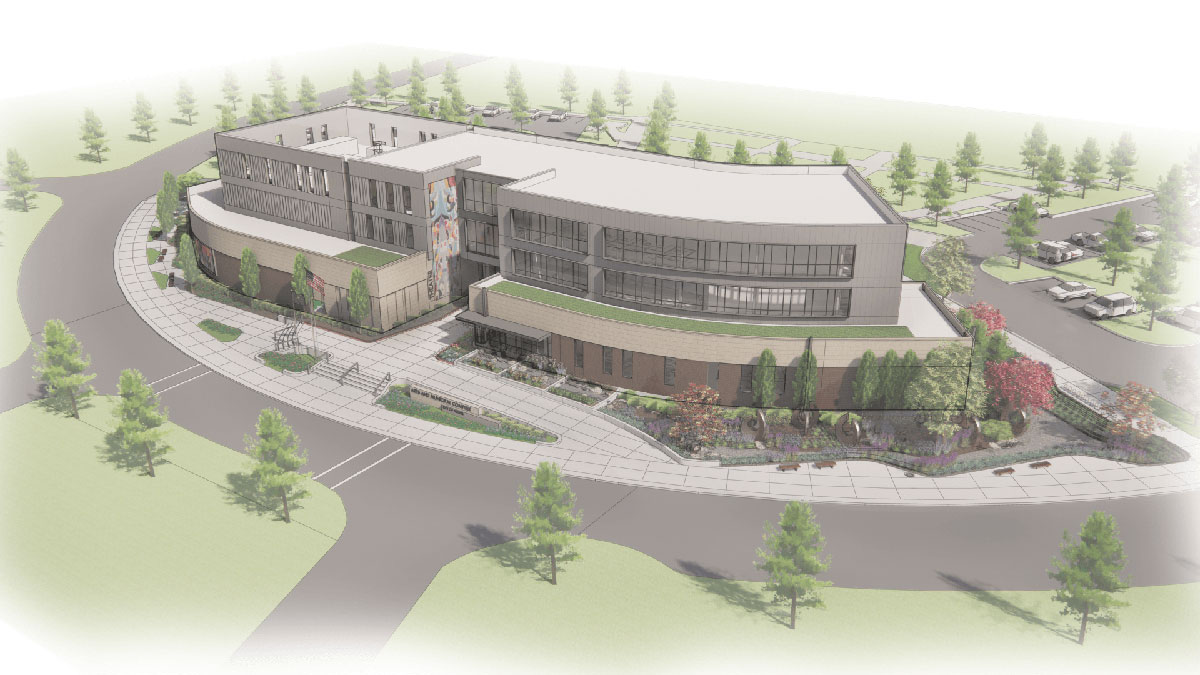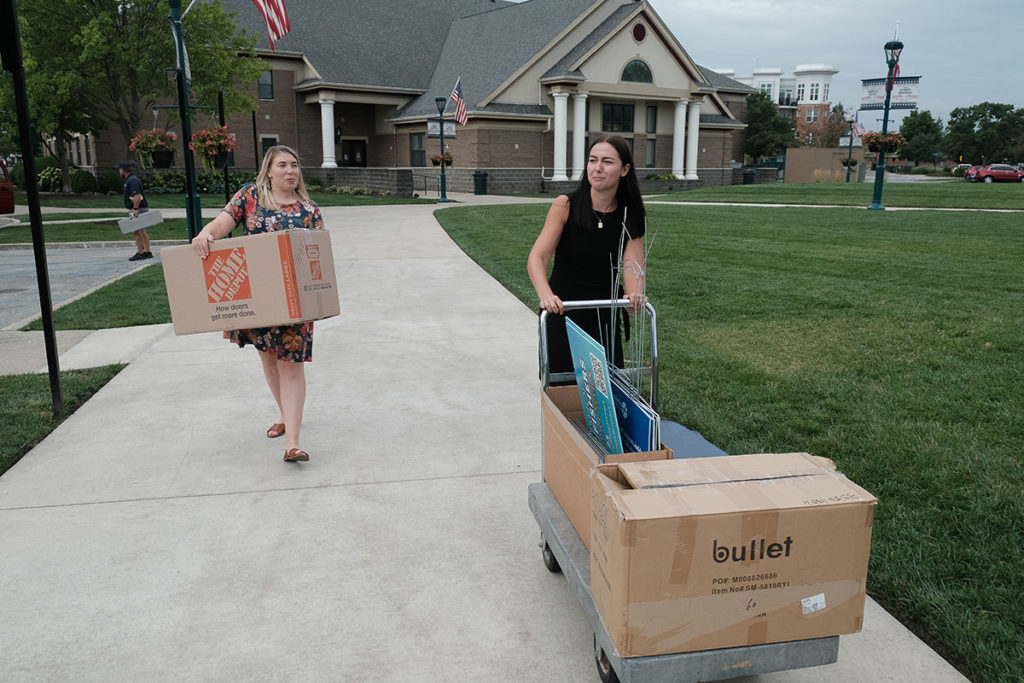[ad_1]
Scott Fadness couldn’t help but feel a sense of nostalgia as he sat in his nearly empty office on the second floor of Fishers City Hall. After all, the building has been the mayor’s second home since he was an intern 16 years ago.
Fishers’ employees and municipal staff, who spent weeks packing, purging and preparing, will leave City Hall on Friday for the final time.
The 31-year-old building will be demolished this fall so construction can begin on the $22.8 million Fishers Arts & Municipal Complex that is scheduled to open in the spring of 2024.
“My entire professional career has been in the confines of this building, so there’s a lot of memories here,” Fadness said.

The need for a new building became increasingly noticeable over the years as the two-story, wood-framed City Hall sank—literally. The western section of the building began to settle into the soft ground immediately after it was built in 1991.
“The ground around Fishers is really swampy, apparently, really just unstable,” Hamilton County historian David Heighway said.
City officials attempted to address damage in 1994 and in 2013, but evidence that the problem remains can be seen in cracks along the walls and can be felt walking across a sloping floor in the city’s engineering department.
Illinois-based engineering firm WJE provided the city with an inspection report in April 2021 that found the city could spend $2.5 million through 2024 to maintain the building but not fix the problem, or it could pay a then-estimated $20.8 million to demolish the building and replace it with a three-story, steel-framed structure.
Fishers City Hall continued to house offices for the mayor and the city’s administration, customer experience, planning and zoning, economic development, engineering and communications departments as officials and developers drew plans for a new facility.
“This building for years has kind of been in flux as to what to do with it,” Fadness said. “So, we haven’t invested much in the lived environment of our employees around here, and, yeah, it’s a pretty tired building.”
Fadness said those who work for the city are “change-oriented” and “excited about the new opportunities.”
Some will work from home until the Arts & Municipal Complex opens, while others will be split between the City Services Building at 3 Municipal Drive and Launch Fishers, the co-working space at 12175 Visionary Way that will also host City Council meetings.
“In some ways, COVID prepared us very well for that kind of remote-working environment,” Fadness said.
He said sitting in the City Hall auditorium recently led him to reflect on his time in the building.
“Whether it was changing the [Nickel Plate] rail line into a trail, whether it was big economic development projects, downtown redevelopment, our announcement of mental health initiatives—they were all in that space, and I can remember the dynamics of those conversations very well,” Fadness said.
‘Rocket-ship growth’
Few places in Indiana have changed more dramatically over the past 50 years than Fishers, whose population increased from 628 in the 1970 U.S. Census to 98,977 in 2020.
The then-town had recently welcomed its 7,500th resident when City Hall opened. The idea of a massive retail destination like Ikea and the construction of housing development after housing development in the small farming community was almost unthinkable.
In the early part of the 20th century, Carmel and Fishers in southern Hamilton County lagged behind towns to the north in population. Heighway attributed that to the natural-gas boom that led to rapid growth in northern Hamilton County and Madison County in the late 19th century.
“Up until the population boom that started in the [1950s], both Carmel and Fishers had the smallest population in the county,” Heighway said. “The big towns were [county seat] Noblesville, Westfield and actually points north earlier on, 100 years ago … like Arcadia and Atlanta.”
Carmel, which had a stop on the state’s interurban rail line, began to grow thanks to its proximity to the Monon Railroad, Heighway added, while trains passing through Fishers on the Nickel Plate Railroad primarily hauled agricultural goods, not people.
It was not until the mid-1990s that Fishers experienced what Fadness called “rocket-ship growth,” which he said was due to its proximity to Indianapolis, cheap farmland that could be used for development, a solid school system and the trend of people leaving cities for the suburbs.
From the turn of the 21st century until the 2008 housing crash, Fadness said, more than 1,000 homes—plus an elementary school—were built per year in Fishers. And since the early 2010s, growth has been more intentional. How to create a downtown and attract businesses are objectives city officials took on directly.
It’s a downtown that features new projects like Nickel Plate Station, developed by Carmel-based developer CRG Residential LLC and Indianapolis-based Browning Investments, that includes the six-story, 180,000-square-foot First Internet Bank headquarters; the planned five-story, 116,000-square-foot Hotel Nickel Plate; 237 apartment units; 10,500 square feet of retail space; and a 337-space parking garage.
And for Fadness, personally, it was a rapid upward trajectory from an intern and graduate student with Indiana University’s School of Public and Environmental Affairs, to town manager at age 28, to the city’s first mayor in 2015.
“We were just in the right place at the right time to grow,” he said.

Building for the future
The eye toward the future now turns to the Fishers Arts & Municipal Complex, which will serve as the centerpiece of the Nickel Plate District.
“I think the building we’re building next is a 50- to 100-year building,” Fadness said. “It’s not a half-step to something. This is going to be the permanent civic home for Fishers, and we tried to be very thoughtful about that in sizing it correctly.”
The city began requesting proposals for the building last year after the WJE inspection report.
Fishers-based Meyer Najem Construction will build the facility on the existing footprint of the 37,000-square-foot City Hall, with a slight expansion east and west.
During the planning stages, the city worked with a focus group to learn what residents wanted most. A space for arts education and experiences was one of the top choices, Fadness said.
The city will partner with the Indianapolis Art Center to program and operate the Fishers Art Center, an arts education facility on the first floor that will include exhibit, performance and gathering spaces. The art center will feature a flexible 300-seat studio theater with varying configuration options to accommodate different performances, meetings and events.
Fishers-based artists, performance groups and not-for-profits will have priority usage of the theater space, which will be designed by Connecticut-based Theatre Projects Consultants.
“Every day, I’m going to walk through an art center to get to work,” Fadness said. “I think that’s cool.”
 The second and third floors of the complex will house city administrative offices, with about 60 office spaces available—a number that will allow for growth.
The second and third floors of the complex will house city administrative offices, with about 60 office spaces available—a number that will allow for growth.
Indianapolis-based Delv Design received a design contract for the municipal complex that will include a large breezeway in the center with access to the Nickel Plate District Amphitheater and a façade featuring Indiana limestone, brick, metal paneling and glass walls.
Landscape architecture will be managed by Indianapolis-based Browning Day.
“It is modern. It’s not your traditional city hall,” said Fishers Economic Development Specialist Jordin Alexander, who is spearheading construction plans. “It’s trying to be open and welcoming to the community with the art center and theater portion. So, I think we definitely have a good balance. I wouldn’t say it’s overly modern in the design, but it’s shaped a little bit more modern than [City Hall].”
The budget for the complex includes $6 million in American Rescue Plan Act funds and $16 million in municipal bonds. No income or property taxes will increase due to the project, according to the city.
The city will use a build-operate-transfer arrangement with Meyer Najem to cap the city’s costs at $22.8 million. That type of public-private partnership—which was authorized by a 2017 state law—shifts the burden of cost overruns to a developer.
“That’s one of the things that we wanted to do to protect ourselves from any unforeseen conditions,” Fadness said.
He said he hopes residents feel welcome inside the complex when it opens in 2024.
“I’d like to come to work where I see lots of Fishers people,” he said. “Not where it feels bureaucratic, and the only people you see in here are the people that work here.”
The complex’s design focuses on how to “invite people to engage and be part of city hall,” Fadness added. “You’d be surprised at how few people donned the halls of this building. I think the design of this new building really [appeals to] people first and then the business of civic government second. And that’s what I’m really excited about.”•
[ad_2]
Source link



